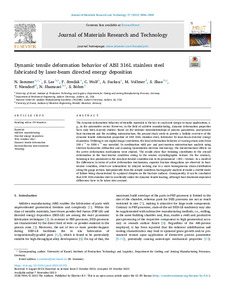| dc.date.accessioned | 2023-12-15T12:10:09Z | |
| dc.date.available | 2023-12-15T12:10:09Z | |
| dc.date.issued | 2023-11-07 | |
| dc.identifier | doi:10.17170/kobra-202312159228 | |
| dc.identifier.uri | http://hdl.handle.net/123456789/15300 | |
| dc.description.sponsorship | Gefördert durch den Publikationsfonds der Universität Kassel | |
| dc.language.iso | eng | |
| dc.rights | Namensnennung 4.0 International | * |
| dc.rights.uri | http://creativecommons.org/licenses/by/4.0/ | * |
| dc.subject | Additive manufacturing | eng |
| dc.subject | Directed energy deposition | eng |
| dc.subject | 316L stainless steel | eng |
| dc.subject | Dynamic tensile deformation | eng |
| dc.subject | Recrystallization heat-treatment | eng |
| dc.subject | Twinning | eng |
| dc.subject.ddc | 600 | |
| dc.title | Dynamic tensile deformation behavior of AISI 316L stainless steel fabricated by laser-beam directed energy deposition | eng |
| dc.type | Aufsatz | |
| dcterms.abstract | The dynamic deformation behavior of metallic materials is the key to crash-safe design in many applications, e.g., in the automotive sector. However, in the field of additive manufacturing, dynamic deformation properties have only been scarcely studied. Based on the intrinsic interrelationships of process parameters, post-process heat treatments and the resulting microstructure, the present study seeks to provide a holistic overview of the dynamic tensile deformation properties of AISI 316L stainless steel, fabricated by laser-beam directed energy deposition. Utilizing in situ digital image correlation, the local deformation behavior at varying strain rates from 100 s-1 to 1000 s-1 was unveiled. In combination with pre- and post-mortem microstructure analysis using electron backscatter diffraction and scanning transmission electron microscopy, the microstructural effects on the active deformation mechanisms were studied. The results show that twinning contributes to the overall deformation in the heat-treated condition owing to the weaker crystallographic texture. On the contrary, twinning is less prominent in the non-heat-treated condition due to its pronounced <001> texture. As a result of the differences in terms of active deformation mechanisms, superior fracture elongations are observed in heattreated condition, which are rationalized by delayed necking due to a more homogeneous strain distribution along the gauge section. Independently from the sample condition, fractography analysis revealed a ductile mode of failure being characterized by equiaxed dimples on the fracture surfaces. Consequently, it can be concluded that AISI 316L stainless steel is excellently suited for dynamic tensile loading, although heat-treatment-depended differences have to be taken into account. | eng |
| dcterms.accessRights | open access | |
| dcterms.creator | Sommer, Niklas | |
| dcterms.creator | Lee, S. | |
| dcterms.creator | Stredak, Florian | |
| dcterms.creator | Wolf, Christian | |
| dcterms.creator | Suckau, Andreas | |
| dcterms.creator | Vollmer, Malte | |
| dcterms.creator | Shao, S. | |
| dcterms.creator | Niendorf, Thomas | |
| dcterms.creator | Shamsaei, Nima | |
| dcterms.creator | Böhm, Stefan | |
| dc.relation.doi | doi:10.1016/j.jmrt.2023.10.251 | |
| dc.subject.swd | Rekristallisation | ger |
| dc.subject.swd | Edelstahl | ger |
| dc.subject.swd | Laserstrahl | ger |
| dc.subject.swd | Deformation | ger |
| dc.subject.swd | Partnerschaft | ger |
| dc.type.version | publishedVersion | |
| dcterms.source.identifier | eissn:2214-0697 | |
| dcterms.source.issue | November-December 2023 | |
| dcterms.source.journal | Journal of Materials Research and Technology | eng |
| dcterms.source.pageinfo | 5896 - 5909 | |
| dcterms.source.volume | Volume 27 | |
| kup.iskup | false | |


